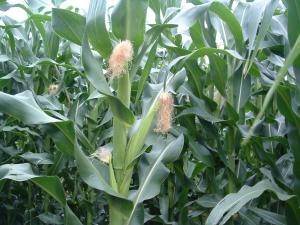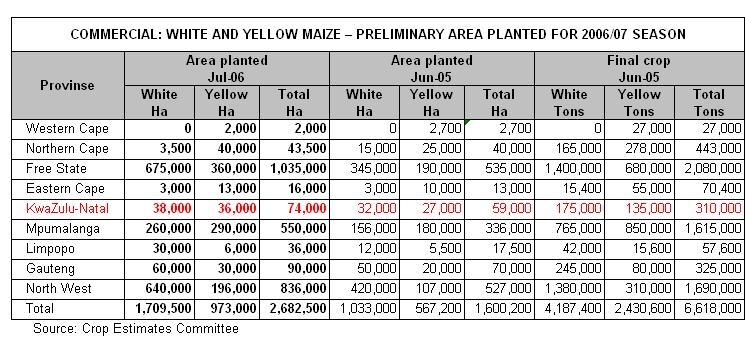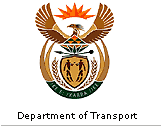 |
Grain and Seed ProductionKwaZulu-Natal has areas of agricultural land devoted to the
production of grain and seed crops, which vary from year
to year, depending on demand and supply, prices and
rainfall. The province is not a major grain producing area
in South Africa. The main grain and seed crops that are
grown in the province are maize, dry beans, soya beans,
wheat and some sorghum.

maize
|
MaizeMaize is the most important grain crop in South Africa,
being both the major feed grain and the staple food for
the majority of the population.
Agriculture as a sector, together with its downstream
activities, contributes 15-16% of the Gross Geographic
Product of KwaZulu-Natal.
The main maize producing areas in South Africa are North
West Province, Mpumalanga, Free State and Northern
KwaZulu-Natal. Smaller amounts are grown in the Eastern,
Western, and Northern Cape, Limpopo and Gauteng.
White maize is generally produced in the western maize
belt, whilst yellow maize is grown in the eastern parts.
More than two-thirds of the maize produced is consumed by
humans (50%) and the animal feed industry (40%), while the
rest is for seed and industrial use (10%).
South Africa’s maize production was historically of
equal
quantities between white and yellow maize, but over the
last few years it has moved towards 65% white and 35%
yellow maize. White maize is considered the product of
choice for human consumption in Southern Africa, while
yellow maize is used mainly for the intensive
livestock industry.
Both white and yellow maize for sale are required to
conform to the strictest grading processes, and are
separated accordingly. Maize must not contain any
contaminants like distasteful odours, foreign matter or
other substances that render it unfit for human and animal
consumption.
Maize prices, and therefore the area planted, have in
recent years been affected by the importation of large
quantities of feed grade maize from the USA, South
America,
Italy and China. As maize prices declined, farmers
withdrew
from
production due to inability to compete with the imported
maize, which is often from subsidised producers.
With the growing emphasis in the USA on producing biofuel
and ethanol from maize, the prices are improving and
production is increasing again. The rising prices will,
however, have significant impacts on the costs of poultry,
milk and meat.

|
The amount of maize produced in KwaZulu-Natal for the year
ending June 2005 was estimated at 310,000 tons, compared
to the national figure of 6,6 million tons, which
constitutes only 4,7% of the national production (see the
table above). In 2003 KwaZulu-Natal contributed
approximately 21% to national maize human and animal feed
consumption, and with Gauteng (24%), accounts for the
largest consumption of maize in South Africa.
As is evident from the table above, the total area planted
for harvesting for 2006 has increased to 74,000 hectares,
compared to 59,000 hectares in 2005. White and yellow
maize is planted during late spring/early summer
months with optimal planting times between November and
December, depending on the expected rainfall. Planting,
however, can start as early as October and extend into
January. The majority of the maize is harvested during the
months from late May till end August. Maize can be stored
in a silo for up to two years, provided it is properly
fumigated against grain insects.
According to the National Department of Agriculture, grain
silos with a capacity of 15,5 million tons (maize
equivalent) were built at 220 depots in the northern parts
of South Africa and 972,852 tons at 46 depots in the
southern parts. There are currently approximately 16,9
million tons of available bulk storage capacity in South
Africa of which 85% of silo capacity is owned by
cooperatives.
In the 2006/07 financial year, the port of Durban exported
67,895 tons of maize and imported 863,975 tons. WheatIn terms of value of production, wheat is the third most
important field crop produced in South Africa. In the
2005/06 season, this crop contributed approximately 12%
to the gross value of field crops. The average annual
gross value of wheat for the past 5 years amounts to R2
681 million, compared to R8 675 of maize, which is the
most important crop. Wheat is planted mainly between mid-
April and mid-June in the winter rainfall area, and
between
mid-May and the end of July in the summer rainfall area.
Most of the wheat produced in South Africa is bread wheat,
with small quantities of durum wheat being produced in
certain areas.
KZN is not regarded as a wheat producing area although
some wheat is planted in the Bergville and Midlands areas.
In 2005, KwaZulu-Natal produced 41,500 tons of wheat.
In the 2006/07 financial year, the import of wheat through
the port of Durban amounted to 936,552 tons. Soya beansThe main use of soya beans in South Africa is for the
production of soya bean oil, primarily used for domestic
cooking and meat substitute for vegetarians. Soya beans
are
classed according to oil content, the higher the oil
content, the better the quality.
After processing to extract the soya bean seed oil, the
residue is soya meal which is primarily used as a protein
supplement in the making of animal feeds.
Soya beans are planted during the summer months, with the
optimal planting times around October till January and
harvest during May till July.
As shown in the above table the main producing areas in
South Africa are Mpumalanga and Free State . In 2005
KwaZulu-Natal produced 62,500 tons of soya beans.
Soya beans can be stored in silos for periods of up to 24
months, but this period can be exceeded if it is kept
under ideal conditions. Grain SorghumSorghum production in South Africa has been falling
steadily with the gradual reduction in demand for the
traditional beer that was one of the main uses of the
product.
Feed sorghums are still produced in some areas for cattle
feed and silage production, but the areas planted vary and
are not recorded.
KwaZulu-Natal is not a major grain sorghum producing area.
In 2005 it only produced 250 tons, compared to the
national figure of 96 000 tons. The main producing areas
are Free State and Mpumalanga.
Dry beans
In 2005, KwaZulu-Natal produced 900 tons of dry beans.
This constituted only 1,3% of the national figure, which
indicates that it is not a major production area.
TransportThe grain industry utilises mostly road transport due to
the policy of the railroad operator with regard to
consignment size and rates. Although grain is rail
friendly, the quantity of grain moved by rail has fallen
from 80% to approximately 40% in 2006.
Imported grain is railed to some centres, but is largely
transported from the ports by large road combinations
directly to feed mills. The total volume imported in 2006
through all ports was 825,000 tons in 2006.
Grains and seeds are generally delivered to silos or other
storage by farmers, and then redistributed to mills that
produce human and animal feeds.
The primary transport of grain and seed crops from farms
to storage silos is performed by farmers using a range
of tractor-trailer units, and a variety of trucks of all
sizes.
|
 |



